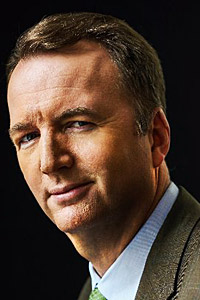
Pre-pandemic Australia looks like hallowed ground that the contemporary economy will struggle to surpass. For local officials who aspire to take a crack at emulating a celebrated decades-long expansion, it's important not to downgrade a vital component that's become radioactive: immigration. The country's politicians are showing a worrying lapse in memory.
As much as any other factor, population growth contributed to the 30-year stretch without a recession that ended in 2020. The country's performance was "flattered", in the words of former Reserve Bank of Australia governor, Philip Lowe, by the rising headcount. A mining boom fuelled by China's go-go years, the dramatic economic reforms of the 1980s -- and some luck -- have tended to get the credit. This misses a fundamental ingredient, and it's too bad.
Aussies loved the attention that came with that dream economic run, a happy state that was feted by think tanks and idealised in the corridors of the Federal Reserve. (There was also an unhealthy degree of back-patting at home.) Will that golden era be replicated in the post-Covid world?
For starters, current leaders need the stomach to stare down one of the country's outbursts of populist aversion to rising numbers of arrivals. Wrestling with a mid-term slump in opinion polls, the centre-left Labor government recently declared it wants substantial cuts. Prime Minister Anthony Albanese pledged to crack down on student visas and tighten conditions for temporary visas available to skilled migrants. It's not long ago that employers were crying out for talent from abroad. Border restrictions during the pandemic slowed immigration, as they did in many countries. Shortages needed to be alleviated.
Some desire to recalibrate is understandable. There has been a big intake: In the last fiscal year to June 30, there were 518,000 new arrivals, according to the Centre for Population in Canberra. The increase was the most on record. The population has climbed greatly over the decades, almost doubling since 1980 to approach 27 million. There is an inevitable strain on resources. Contrary to images of outback ruggedness popular in books and films, Australia is one of the most urbanised societies. Most residents are crammed into a handful of cities along the southeast coastline. Backlash flares from time to time, some of it nativist and emanating from right-wing talk radio. The surge has been blamed for squeezing an already tight housing market that has seen rents soar in the major cities. Other arguments reflect genuine concern about environmental strain.
What's troubling about this current retreat is the electoral environment in which it is happening. Mr Albanese's administration has been on the defensive for months. There's a sense that it's lost momentum since a referendum on constitutional recognition for indigenous Australians flopped in October. The prime minister campaigned hard for that initiative, and his team seems to be flailing around in the aftermath of defeat. They are unnerved by a slide in approval, a perfect backdrop for populist attacks on immigration to hurt. "We've got to make sure that our population is sustainable," Mr Albanese said in December. "What I want to see is a system that works for Australia."
When officials talk about population, they really mean immigration. Like just about every advanced economy, and quite a few emerging markets, couples Down Under aren't having nearly enough kids to keep numbers steady. This doesn't get enough attention. The fertility rate (TFR) of 1.58 children per woman is well below the generally recognised replacement level of 2.1. While Australia's total fertility rate is fairly high in a region where birthrates are retreating at a rapid clip, the trend is similar. In 1961, Australia's TFR was 3.5.
The present kerfuffle is an argument about whether Australians want a country that is big in numbers as well as landmass, and an economy that continues its march up the world tables or just drifts around, ultimately slipping outside the Group of 20, membership of which Australia has often prided itself.
You hear very little of this in popular discourse. Mr Albanese has been cowed into adopting the language of the right, using the word "broken" to describe the immigration programme. It begs the question: Was it ever "whole", and, if so, what did that look like? It's never been entirely free of controversy. That isn't the same as saying there aren't broad merits. Over the decades, a wide-ranging immigration programme has transformed, mostly for the better, Australian cultural and economic life.
Also buffeting Labor and getting in the way of a nuanced conversation is the High Court-ordered release of long-term detainees. (Under strict policies that date to the early 2000s, thousands of asylum seekers arriving by boat have been sent to detention centres.)
Some of those released had been charged with violent crimes, but couldn't be deported due to concerns about persecution, and possibly death sentences, in their countries of origin. The court makes decisions independently, but the government is paying the political price. As will the economy.
It's a shame Mr Albanese is spooked. Immigration was enshrined in post-World War II development by the Labor governments of John Curtin and Ben Chifley. Leaders spoke of the need to "populate or perish", a slogan that was in part a residual fear of invasion, but also a recognition that a new Australia with different macro-economic and strategic settings had to emerge from the conflict.
Immigration at that time meant, initially, the UK. It was then broadened to include the Baltic states, the Mediterranean, and the rest of Europe. Race was still relevant: The so-called White Australia Policy endured in practice until the 1970s. After the Vietnam War, newcomers from Indo-China were welcomed.
To the credit of conservative leaders in the 1950s, '60s and '70s, immigration retained broad bipartisan support.
It would be very unfortunate if a return to pseudo-normality after Covid spelt the demise of a true Australian success story. The country doesn't know how lucky it is. ©2024 Bloomberg
Daniel Moss is a Bloomberg Opinion columnist covering Asian economies.
